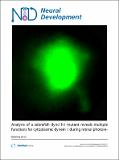Analysis of a zebrafish dync1h1 mutant reveals multiple functions for cytoplasmic dynein 1 during retinal photoreceptor development
Author(s)
Insinna, Christine; Baye, Lisa M.; Amsterdam, Adam; Besharse, Joseph C.; Link, Brian A.
Download1749-8104-5-12.pdf (4.371Mb)
PUBLISHER_CC
Publisher with Creative Commons License
Creative Commons Attribution
Terms of use
Metadata
Show full item recordAbstract
Background: Photoreceptors of the retina are highly compartmentalized cells that function as the primary sensory neurons for receiving and initiating transmission of visual information. Proper morphogenesis of photoreceptor neurons is essential for their normal function and survival. We have characterized a zebrafish mutation, cannonball, that completely disrupts photoreceptor morphogenesis. Results: Analysis revealed a non-sense mutation in cytoplasmic dynein heavy chain 1 (dync1h1), a critical subunit in Dynein1, to underlie the cannonball phenotypes. Dynein1 is a large minus-end directed, microtubule motor protein complex that has been implicated in multiple, essential cellular processes. In photoreceptors, Dynein1 is thought to mediate post-Golgi vesicle trafficking, while Dynein2 is thought to be responsible for outer segment maintenance. Surprisingly, cannonball embryos survive until larval stages, owing to wild-type maternal protein stores. Retinal photoreceptor neurons, however, are significantly affected by loss of Dync1h1, as transmission electron microscopy and marker analyses demonstrated defects in organelle positioning and outer segment morphogenesis and suggested defects in post-Golgi vesicle trafficking. Furthermore, dosage-dependent antisense oligonucleotide knock-down of dync1h1 revealed outer segment abnormalities in the absence of overt inner segment polarity and trafficking defects. Consistent with a specific function of Dync1h1 within the outer segment, immunolocalization showed that this protein and other subunits of Dynein1 and Dynactin localized to the ciliary axoneme of the outer segment, in addition to their predicted inner segment localization. However, knock-down of Dynactin subunits suggested that this protein complex, which is known to augment many Dynein1 activities, is only essential for inner segment processes as outer segment morphogenesis was normal. Conclusions: Our results indicate that Dynein1 is required for multiple cellular processes in photoreceptor neurons, including organelle positioning, proper outer segment morphogenesis, and potentially post-Golgi vesicle trafficking. Titrated knock-down of dync1h1 indicated that outer segment morphogenesis was affected in photoreceptors that showed normal inner segments. These observations, combined with protein localization studies, suggest that Dynein1 may have direct and essential functions in photoreceptor outer segments, in addition to inner segment functions.
Date issued
2010-04Department
Koch Institute for Integrative Cancer Research at MITJournal
Neural Development
Publisher
BioMed Central Ltd
Citation
Neural Development. 2010 Apr 22;5(1):12
Version: Final published version
ISSN
1749-8104